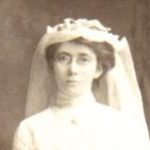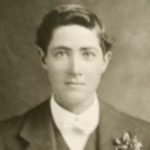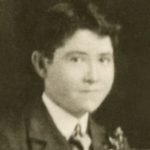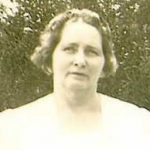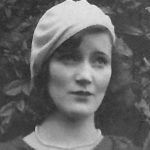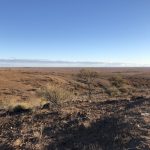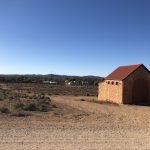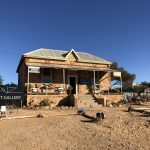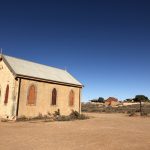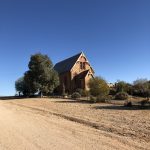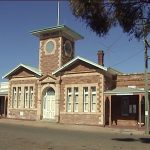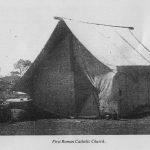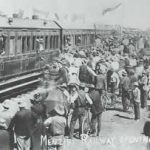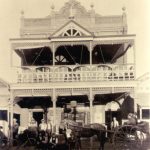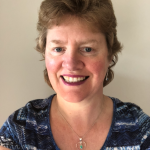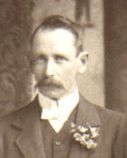
Nicholas W M Bolle 1911
Nicholas William Michael Bolle was born on 2 July 1860 in Ironstone Hill, near Bendigo, Victoria, Australia.
Like his eight siblings, he was baptised at the Roman Catholic church of St Kilian’s in Bendigo, or Sandhurst as it was then known as.
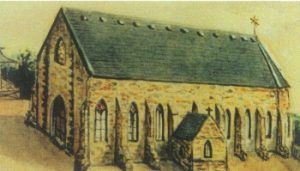
St Kilians stone church founded 1857
Nicholas was baptised on 9 September 1860, the son of German born gold miner Nicholaus John Bolle (1836-1899) and Rosanna Elizabeth Farrell (1839-1905).
Given that the family lived in the Whipstick forest, young Nicholas would have been helping out his father at the mine site from a young age, which we can see from a hospital admission record for him at the age of 13. Nic junior was admitted to hospital with burns to the face.
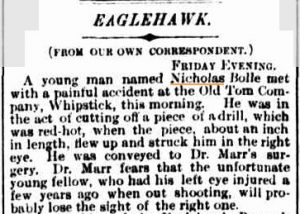
The Argus, 12 Jan 1884
Mining was a dangerous occupation in primitive conditions, and at the age of 19 he was injured in another accident requiring hospital treatment, this time receiving severe gunpowder burns to the face and neck (Argus 27 Feb 1879).
That wasn’t the end of his hospital visits. In January 1884, Nicholas now 23 was involved in an accident injuring his right eye, possibly causing permanent blindness.
According to Brendan’s grandfather (Charles Pickering), Nicholas played in the German Hanover band in Bendigo, perhaps not surprising as his father was also described as a musician on his immigration documents.
At the age of 24 Nicholas obtained his Engine Driver’s Certificate in December 1884, and shortly after decided to leave his family, and the Bendigo area and follow the well worn track to try his luck at mining in Broken Hill, New South Wales, almost 700 kms away.
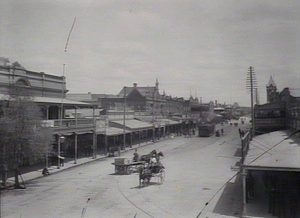
Old Broken Hill
Broken Hill was founded just the year before in 1883 by boundary rider Charles Rasp, who patrolled the Mount Gipps fences. In 1883 he discovered what he thought was tin, but the samples proved to be silver and lead.
The orebody they came from proved to be the largest and richest of its kind in the world. Mr Rasp and his friends formed the company which is now known as BHP (Broken Hill Proprietary company). The company started mining the massive ore body containing the world’s richest source of silver, lead and zinc, and many miners, such as young Nicholas Bolle were lured away from the promise of gold to try their luck in the ‘silver city’.
Many miners worked in deplorable conditions; breathing silicon-laden dust while working underground or the lead fumes produced by the smelters. Many died of miners’ phthisis or lead poisoning.
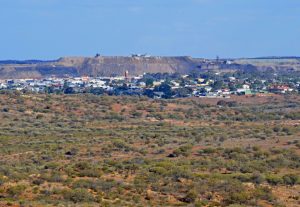
Broken Hill 2019
Nicholas soon starting participating fully in the community of Broken Hill, and can be found competing in the running races at the Hibernian Society Sports Day, held on St Patrick’s Day on 12 March 1889.
He is also part of the Friendly Society Council arranging concerts, and sporting events in May 1893.
Perhaps at one of these events he met his future wife, Mary Ellen Clarke, who he married at the Sacred Heart Catholic Church in Broken Hill on 16 February 1890. 29 year old Nicholas stated he was a bachelor, occupation engine driver, and spinster Mary was working as a domestic.
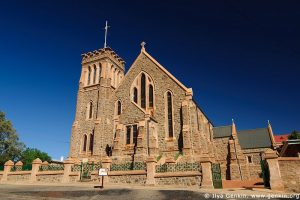
Sacred Heart Cathedral Broken Hill
Witnesses to the marriage were Francis Bannigan and Julia Ahern. Mary’s father Michael James Clarke gave consent for the marriage to occur, stating that Mary was under age being just 18 years old.
Mary Ellen Clarke was born on 26 October 1871 in Napperby, South Australia (according to her death certificate), but no birth registration can be found. She was the daughter of Irish born miner Michael James Clarke (1841-1896) and Margaret Mary Simons (1848-1922).
Mary was the oldest of six children born to the couple, and during her childhood the family lived at Napperby in the Clare Valley, South Australia where her father was the storekeeper. The family moved to Broken Hill sometime between 1883 and 1889 when they first appear in the town’s electoral roll for 1889 living in Oxide Street in North Broken Hill. Mary’s father is now described as a labourer.
Nicholas and Mary had six children, of whom only five survived childhood –
- Isobel Mary b 1890 Broken Hill d 1976 Subiaco, WA married Charles Pickering
- Cyril Nicholas b 1892 Broken Hill d 1915 killed in action at Gallipoli, Turkey
- unamed baby boy b 13 December 1893 d 1893
- Norman Leslie b 1895 Broken Hill d 1962 Perth, WA not married
- Dorothea Mary b 1903 Menzies, WA d 1991 Belmont, WA marr Walter Douglas
- Rita Margaret b 1913 Subiaco, WA d 1948 Perth marr Frank Hodges
- Isobel Pickering nee Bolle 1911
- Cyril Bolle
- Norman Bolle
- Dorothea Douglas nee Bolle
- Rita Hodges nee Bolle
The family appear in the 1891 census of Broken Hill living beside Mary’s father Michael (who states he has one male and six females in his household). Nicholas, states he has one male, and two females under his roof).
In the Barrier Miner Business Directory for the same year in 1891, Nicholas, an engine driver, gives his address as Lane Street, South East side.
In 1892, Nicholas appears in the NSW Government Gazette applying to purchase land at Picton on the Albert Goldfields in the district of Willyama. This was an small area of land about 60 metres square, was about 200 kms east of Broken Hill. The appraised value was 15 pounds. It looks like Nicholas was going to try a bit of gold mining of his own.

NSW Applications to purchase land 1892
From 1880 to the early 1920s gold was mined across the Albert goldfields. History tells us that most of those that rushed to the area were ill prepared for the harsh conditions. Armed with picks, shovels and a tent into terrain only recently explored, conditions were described by Sturt as a ‘stoney, waterless waste’. Apart from the lucky discovery of surface nuggets, little profit was made. Reports of incompetent management, faulty machinery and lack of water contributed to the miners starving, running out of both food and water. Typhoid and other illnesses swept through the unsanitary camps.
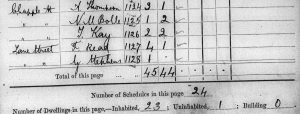
1891 Broken Hill census N M Bolle
By the following year in 1894 Nicholas returned to Broken Hill, and is recorded on the electoral rolls there from 1894 to 1900 living in Chappel Street, and working as an engine driver.
In 1896, the year that Mary’s father dies, he gives evidence at a coroners inquest into a mining fatality, while he was driving an engine at Consols Mine. The jury returned a verdict of accidental death for Otto von der Rodda who was killed at the mine. His brother Richard Rodda spoke and said his death left a widow and three children, another sad, but probably common occurrence in the mining town.
In 1897 Nicholas is competing at a Druids Gala sports day at nearby Silverton. Silverton is a small town, 26kms north west of Broken Hill. Silver was discovered there in 1875, and the population peaked in the 1890s at 3000 people. By 1901 the population had declined to 300 people, but the town remained a popular place for outings for Broken Hill residents. (The photos below are from a visit I made to Silverton in 2018).
Nicholas also appears on the committee of the United Ancient Order of Druids, an organisation set up as a non-religious, friendly society promoting benevolence, justice and friendship. Friendly societies and lodges, such as the Druids in Broken Hill flourished from the late 1870’s with large memberships. Nicholas was a member of the Druids, and was a prominent member of the Druids Triumph Lodge No 448 and the Druids Imperial Lodge No 70.
The Imperial Lodge was instituted in North Broken Hill in August 1890, the membership over 300 men. The lodge set up a funeral fund for members with families contributing six pound per head. The Triumph Lodge was set up in July 1896.
On 22 March 1898 a social occasion was held in the town as a farewell to Nicholas Bolle and his family, who were leaving for Western Australia.
The family made their way 500kms south from Broken Hill down to the port of Adelaide, where on 9th April 1898 they caught the SS Rockton with W J Simpson as master, bound for the port of Freemantle, Western Australia.
The records state that aboard was Mr and Mrs Bolle and three children. (7th from bottom)
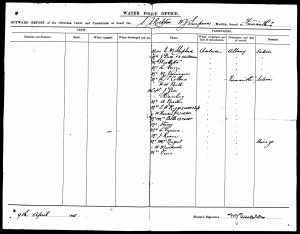
WA Crew and Passenger Lists 1898
Perhaps the family stayed in Perth a while, before heading over to the tiny outback WA town of Menzies, where Nicholas, engine driver and his wife Mary, housewife, appears on the electoral roll for 1903.
Menzies is 728 kilometres east-northeast of Perth, and gold had been discovered in the area in 1894, causing many to try their luck in the desolate, water deprived environment.
Land around the town was sold in 1895 and by 1896 and a railway line was constructed from Kalgoorlie to Menzies opening in 1898. By 1900, Menzies had a population of approximately 10,000 with thirteen hotels and two breweries, so it was certainly booming when Nicholas and his family arrived.
- Menzies Town Hall 2010
- First Catholic Church
- Opening of the Menzies Railway
- Menzies Grand Hotel
There were applications for 320 mining leases, with an average area of 14 acres and within a six km radius of the post office. Water had to be carted to the town from underground supplies and from lakes in the surrounding areas. The government started construction of a dam in 1897 that began to supply water to the town by 1901. The gold rush lasted for about 10 years and by 1905 most of the miners had left town to try their luck elsewhere. By 1910 the population of the town had declined to less than 1,000.
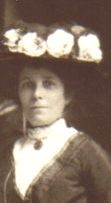
Mary Ellen Bolle 1911
In 1906 Nicholas had moved to Coolgardie (160 kms due north of Menzies) to try his luck, and he is living and working as an engine driver on the Leinster Gold Mine field according to the electoral roll. Perhaps Mary and the children stayed in Menzies as they also both appear in the Menzies Electoral Roll for the same year. The mine at Coolgardie was said to be an open cut affair, with a good crushing plant, but returns were low grade. (Warden’s Report on the Coolgardie Goldfield for the year 1900).
From 1908 to 1911 the family can be found living at 69 Jewell Street, in East Perth, and Nicholas’s occupation is still given as an engine driver (WA Post Office Directory). Nicholas is now 48 years old.
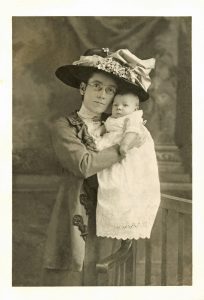
Mary Bolle (nee Clarke) and daughter Rita in 1913
From 1912 to 1920 the family lived at Aberdare Street in Subiaco and then in 1922 can be found living at the corner of Leake Street and Guildford Road in Bayswater, Perth.
Nicholas is still involved in charitable organisations, such as the Druids and on 22 September 1915 we find him raising money for the Red Cross Fund (War Effort) by promoting a dance benefit at the Progress Hall in West Subiaco in the local newspaper. Admission was set at 6d.
Having just lost a son (Cyril Nicholas Bolle) at Gallipoli in April that year, Nicholas must have been compelled to raise money for the troops. Actually Nicholas and the family were still waiting to hear from the War Department as to the fate of their missing son Cyril, and in August they were still writing to the Army inquiring as to his whereabouts.
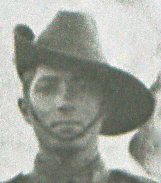
Cyril Bolle 1914
Lance Corporal Cyril Bolle fought in the 11th Battalion in the Australian Imperial Force, and was killed in action at Gallipoli at the age of 35 leaving a wife and four young daughters between the ages of 9 and 14. Cyril appears in the famous Gallipoli photograph at Cheops in Egypt with his battalion.
By 1916 the family is living in West Subiaco at the corner of Kitchener St and Aberdare Road, with both himself and his bachelor son Norman working as engine drivers.
Nicholas, suffering from tuberculosis, almost certainly caused by his career in mining, must have decided on a change of career and at the age of 65 he had moved again out to Mills Rd, Gosnells in Perth where he would work and live until 1933, working as an orchardist. His son Norman was back living with them in 1931, occupation labourer.
Mary Ellen Bolle, nee Clarke, died on 29 December 1929 at the age of 58 years. Her death certificate gives her cause of death as arterial sclerosis and cerebral haemorrhage. Her probate states that she died intestate, so her estate was granted to her husband Nicholas.
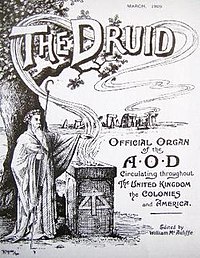
Druid Magazine 1909
Nicholas lived for another five years, and died on 27 May 1934 at the Public Hospital in Perth after a battle with pulmonary tuberculosis.
His multiple death notice describes him of Mills Road in Gosnells, Vice President of the Gosnells Cricket Club, and member of the Druids (Victoria Park Lodge No 345 and Gosnells Lodge No 112).
His will appointed his solicitor as executor and guardian of his youngest child Rita in her minority (she had not yet turned 21). He then bequeathed all his estate, real and personal to Rita alone.
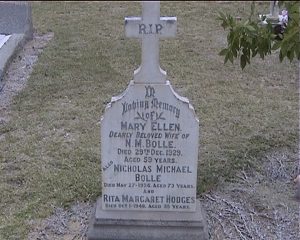
Karrakatta Cemetery, Roman Catholic section
Nicholas was buried in Karrakatta Cemetery in Perth on 29 May 1934 aged 73 years.
He was buried with his wife Mary, son Norman and daughter Rita Hodges.
Sadly Rita passed away at the young age of only 35. Norman passed away aged 67 in 1962. They are buried in the Roman Catholic Section, BA 0469.

